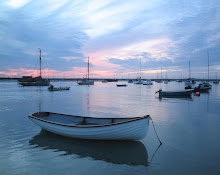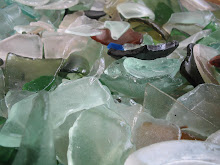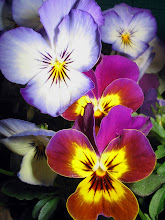 Auntie Clarice, Auntie Blanche and Auntie Elizabeth were my father’s three voluminous maiden aunts, who lived in the family home in Fenton – the ‘forgotten’ sixth town of Stoke-on-Trent, and the one Arnold Bennett famously left out of his novels. They kept house for their parents and subsequently for their unmarried brother, who ran the family tailoring business (of which more another day).
Auntie Clarice, Auntie Blanche and Auntie Elizabeth were my father’s three voluminous maiden aunts, who lived in the family home in Fenton – the ‘forgotten’ sixth town of Stoke-on-Trent, and the one Arnold Bennett famously left out of his novels. They kept house for their parents and subsequently for their unmarried brother, who ran the family tailoring business (of which more another day). Auntie Elizabeth died before I was born, but Aunties Clarice and Blanche were still going strong in the early 1960s. They visited infrequently (they didn’t drive and only rarely made the journey down to Berkshire), but as the only little girl in the family at the time, I was doted on by them and showered with presents of books and toys. I wish I’d had a chance to know them better, but both died before I reached my teens, and I was always too scared of their large flowery dresses, thick brown stockings and strange hats to speak to them, apart from whispering the mandatory pleases and thank yous. They were spoken of as being ‘very artistic’, and there is certainly much evidence of their creative endeavours in the form of paintings and collages, embroidery and, most notably, wood-carving.
Auntie Elizabeth died before I was born, but Aunties Clarice and Blanche were still going strong in the early 1960s. They visited infrequently (they didn’t drive and only rarely made the journey down to Berkshire), but as the only little girl in the family at the time, I was doted on by them and showered with presents of books and toys. I wish I’d had a chance to know them better, but both died before I reached my teens, and I was always too scared of their large flowery dresses, thick brown stockings and strange hats to speak to them, apart from whispering the mandatory pleases and thank yous. They were spoken of as being ‘very artistic’, and there is certainly much evidence of their creative endeavours in the form of paintings and collages, embroidery and, most notably, wood-carving.
 When the last-surviving brother (apart from my grandfather, who was the youngest in the family) passed away, the family house was cleared and the accumulated ‘effects’ of two generations of Holmeses painstakingly sorted out by my father and his brother over many months. A number of things eventually came my way: pretty items from the vast collection of locally manufactured Staffordshire ceramics; jewellery; and, perhaps best of all, a copy of A Handbook of Plant-Form by Ernest E. Clark.
When the last-surviving brother (apart from my grandfather, who was the youngest in the family) passed away, the family house was cleared and the accumulated ‘effects’ of two generations of Holmeses painstakingly sorted out by my father and his brother over many months. A number of things eventually came my way: pretty items from the vast collection of locally manufactured Staffordshire ceramics; jewellery; and, perhaps best of all, a copy of A Handbook of Plant-Form by Ernest E. Clark.
 Subtitled ‘For Students of Design, Art Schools, Teachers & Amateurs’, it comprised 'nearly 800 illustrations, Drawn and Described, and with an Introductory Chapter on Design and A Glossary of Botanical Terms by Ernest E. Clark, Art Master, Derby Technical College, National Silver Medallist in Ornament and Design'. It was published by Batsford in 1904 and the title page bears the quotation:
Subtitled ‘For Students of Design, Art Schools, Teachers & Amateurs’, it comprised 'nearly 800 illustrations, Drawn and Described, and with an Introductory Chapter on Design and A Glossary of Botanical Terms by Ernest E. Clark, Art Master, Derby Technical College, National Silver Medallist in Ornament and Design'. It was published by Batsford in 1904 and the title page bears the quotation:
“In every object there is inexhaustible meaning; the eye sees in it what the eye brings means of seeing.”
I have Googled till my Googling-finger aches, but I all I have been able to find out about Ernest Ellis Clark (1869-1932) are a few references to this publication and some scanty biographical details.
He was born in Derby and studied at Derby School of Art, which he first attended as an evening industrial student in 1892, and where he was considered one of the most outstanding students.
 He became a painter at the Royal Crown Derby Porcelain Company, where he stayed until 1902. He left the china works to become a full-time crafts instructor at the School of Art in Green Lane, Derby. Between 1899 and 1904 he won seven medals in the National Competition for schools of art. He was a member of Derby Sketching Club, and seems to have specialised in painting Derby townscapes and people. From 1914-1918 he served as a gunner in the Royal Field Artillery and he died in Derby in 1932 aged 63.
He became a painter at the Royal Crown Derby Porcelain Company, where he stayed until 1902. He left the china works to become a full-time crafts instructor at the School of Art in Green Lane, Derby. Between 1899 and 1904 he won seven medals in the National Competition for schools of art. He was a member of Derby Sketching Club, and seems to have specialised in painting Derby townscapes and people. From 1914-1918 he served as a gunner in the Royal Field Artillery and he died in Derby in 1932 aged 63. I've unearthed one fuzzy reproduction of a Derby street scene, but have not managed to find any other images of his paintings.
I've unearthed one fuzzy reproduction of a Derby street scene, but have not managed to find any other images of his paintings.So it looks as though pretty much all that remains of Mr Clark’s life’s work is this wonderful book. My copy was presented to Auntie Clarice as a school prize ‘for Flower Painting’, and clearly inspired many of her wood-carving designs (which I should have photographed when I was staying with my parents - I'll do so next time).
 In his Preface, Clark sets out his very sensible teaching philosophy:
In his Preface, Clark sets out his very sensible teaching philosophy:
‘Objection may be taken to [‘this little work’] on the debatable ground of the wisdom of placing in the hands of Art students ready-made diagrams for reference and use in decorative studies. But this objection may be met by a consideration of the difficulties experienced by many young students in obtaining, at any given moment, the right plant, or the information concerning such plant, which is essential in order to make an original drawing. At the same time, it cannot be too frequently urged upon students that the only right way for them is to make their own studies direct from nature. Indeed, one object of this book would be defeated if it were made to take the place of a student’s own personal studies . . . I have refrained from supplementing the plant drawing with examples of their decorative application to given spaces, believing that, had I done so, a check might possibly have been put upon the student’s originality . . . .’ But oh what a treasure-house this is. Its Arts & Crafts approach appealed to me from the moment I first opened it and it has proved a fantastic resource over the years. I’ve referred to it for help with everything from Biology A-level to needlepoint designs for cushion covers and ideas for botanical drawings.
But oh what a treasure-house this is. Its Arts & Crafts approach appealed to me from the moment I first opened it and it has proved a fantastic resource over the years. I’ve referred to it for help with everything from Biology A-level to needlepoint designs for cushion covers and ideas for botanical drawings.
 Some of the plates have been beautifully watercoloured by my aunt – which is a ‘defacement’ I find delightful (the very best kind of scribbling to discover in a book!).
Some of the plates have been beautifully watercoloured by my aunt – which is a ‘defacement’ I find delightful (the very best kind of scribbling to discover in a book!).
I’ve scanned just a few pages for now, but will post some more soon if people are interested. And I need hardly add that if anyone knows anything more about Ernest Clark or his work, I’d be absolutely delighted to hear from you.
(Don't forget to click on the images to enlarge them.)





















6 comments:
The book is glorious! More please.
sherry
What a great book! Love the daffodils.
Take a look at this eBay listing signed by E. Clark.
Exquisite Signed Royal Crown Derby Cobalt & Gilt Urn - 260625334303
Thanks, Wayne, that's absolutely fascinating.
Ernest has three paintings in Dervy Museum and now has a wikipedia entry. There is a chance to see them at the backstage event on April 9th.
Hi Juliet, I have also been looking for information on this wonderful book by Ernerst Clarke and stumbled across your blog. Like your aunts I was also born in Fenton (Foley) and I wondered did they work in the pottery industry or perhaps even study painting? Would love to hear more about this if you have any snippets of info. I worked in the pottery industry when I was in my early 20's in the design studio at Royal Albert and my mother worked for Royal Doulton for many years. I now work as a botanicla artist and I'm interested in finding more out about artists in the Potteries. Thanks Dianne www.diannesutherland.com
Post a Comment